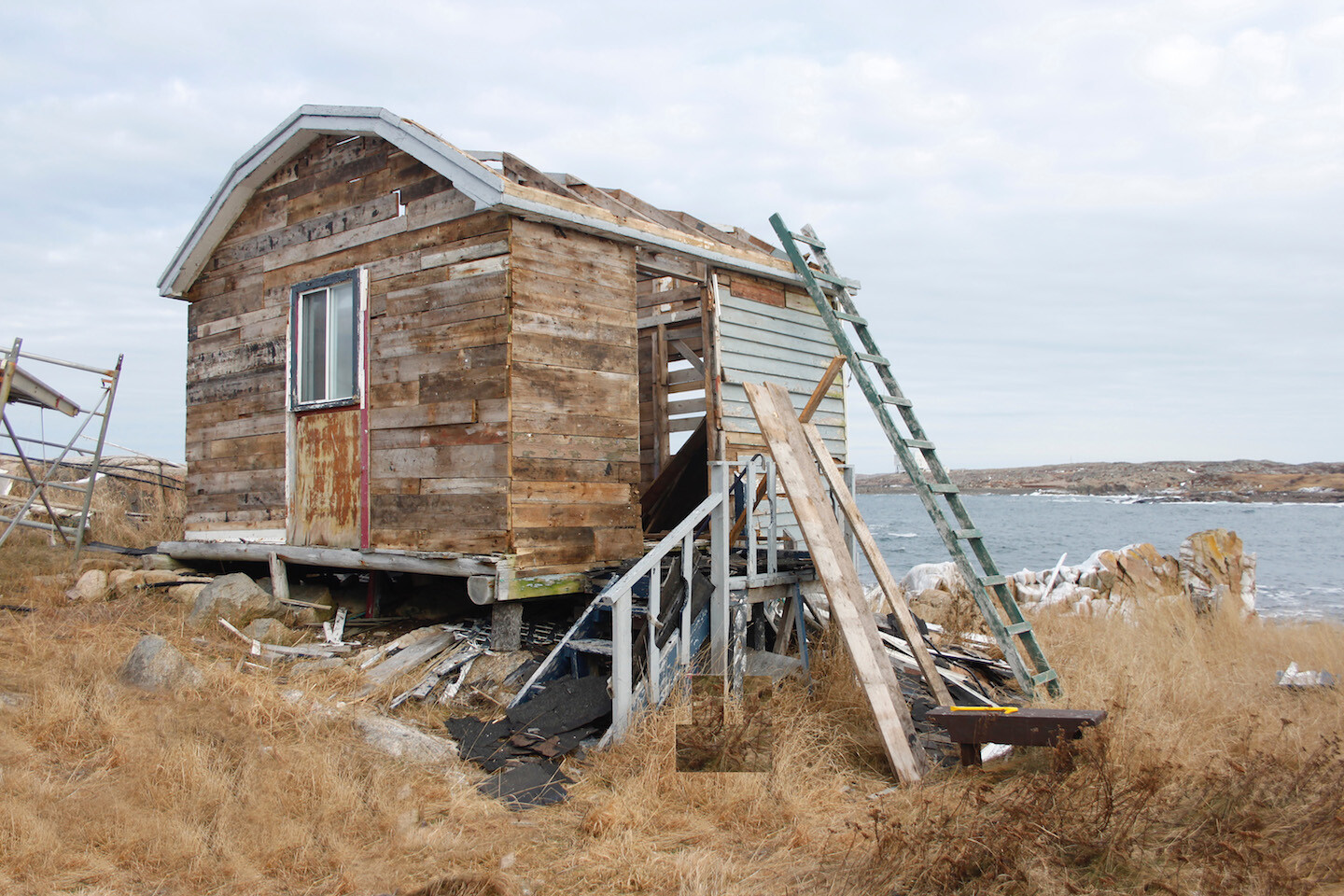Four Sheds
December 23, 2016–April 2, 2017
210 Main Street, Joe Batt’s Arm
Newfoundland and Labrador A0G 2X0
Canada
Lithuanian artist Augustas Serapinas presents Four Sheds, a site-specific installation at the Fogo Island Gallery that reconfigures an abandoned shed into another form of container. Presented as part of Fogo Island Arts’ emerging artist exhibition series, Four Sheds evokes a history of materials, techniques and traditions, and the human processes embedded within them.
Every shed has a purpose. Across Fogo Island and Newfoundland, small-scale peak-roofed structures are used for storing firewood and fishing nets, for gutting and cleaning fish, repairing boats or amassing junk. Commonplace, vernacular wooden structures, they nonetheless contain within them a modest history of culture and material usage.
With help from three members of the community, Serapinas dismantled an existing shed on Barr’d Islands, Fogo Island, that was destined to be torn down. According to local knowledge, the shed was in fact the third iteration of a similar structure, a slightly different configuration of wooden boards, nails and shingles assembled according to need. Over time, more contemporary additions such as vinyl siding, wallpaper-covered panels and a discarded front door had been integrated with older wooden materials. Thus cobbled together, the shed reflects a natural and economic reuse of materials, a resourcefulness borne of necessity.
Taken from the original site to the Fogo Island Gallery, the materials of the Barr’d Islands shed are once again reassembled into a new structure that bears its history in peeling paint, handwritten measurements, and notched surfaces.
From a frontal perspective, the new construction resembles a shed, but viewed at an angle it is deceptively shallow. Its shape and size have been determined according to a new purpose and context. The structure’s width ensures it fits through the doors of the gallery, and it is long enough to contain the leftover boards, roof trusses, posts and steps. At the end of the exhibition, the shed’s roof will be removed and stored inside it, transforming the structure into a shipping crate that will travel from Fogo Island to Europe, where it will be dismantled and rebuilt again into other shed-like forms. Like a traveller or immigrant who brings traditions and skills from home and adapts them to a new situation, the shed will take on another life that is dependent on its context.
There is of course an element of the absurd in building and shipping a large crate made from its constituent parts. The initiative calls to mind Jorge Luis Borges’ story of exacting cartographers whose map of their empire matched precisely the scale of the original, a map that would later be seen as irreverent, and then abandoned to the elements.
Yet Serapinas’ work is not a perfect replica of the original. His reconfiguration of the shed is an act of heritage preservation in which he saves a traditional building destined for demolition. This form of preservation does not fix the shed as an artifact, stifling any future development. The shed/crate is in keeping with building and material traditions on Fogo Island that are at once driven by necessity and open to future purposes. In this way, the work employs a form of appropriation and reuse that affirms cultural traditions as ever evolving.
The foreshortened proportions of Four Sheds also speak to the broader problematics of representation, wherein any sign or symbol of a thing is potentially a reduction of the original, and its interpretation is mediated by cultural context and individual perspective. Serapinas’ work is ultimately a modest gesture that speaks of larger things: of place, of shared understandings, of labour and exchange, of material and immaterial things and the structures we build to contain them.
The exhibition is curated by Alexandra McIntosh (Director of Programs and Exhibitions, Fogo Island Arts) and Nicolaus Schafhausen (Director, Kunsthalle Wien and Strategic Director, Fogo Island Arts).
Artist’s biography
Augustas Serapinas is based in Vilnius, Lithuania. He received his BA in Sculpture from the Vilnius Academy of Art in 2013. In 2014 he received the “Best artistic debut of the year” prize awarded by the Culture Ministry of Lithuania. Recent exhibitions include: Housewarming, Emalin, and Dusting the Grounds, DRAF (David Roberts Art Foundation), London; Jõusaal (gym), Frieze London Live 2016; How to gather? (6th Moscow Biennial); Phillip, Lukas & Isidora, Salts, Switzerland; The Future of Memory, Kunsthalle Wien; Don’t You Know Who I Am? Art after Identity Politics, Museum of Contemporary Art, Antwerp; Utopian City, Survival kit 6, The Latvian Centre for Contemporary Art; and Unanswered Q, Contemporary Art Centre, Vilnius.
About Fogo Island Arts
Fogo Island Arts is a residency-based contemporary art venue that supports research and production of new work for artists, filmmakers, writers, musicians, curators, designers and thinkers from around the world. Since 2008, FIA has brought some of the most exciting emerging and renowned artists of today to Fogo Island, Newfoundland, Canada to take part in residencies and to present solo exhibitions at the Fogo Island Gallery. Combining contemporary art, iconic architecture and social innovation in a singular setting, FIA is a world-class institution that is uniquely rooted in community. FIA is an initiative of the Shorefast Foundation, a registered charity dedicated to improving the social, cultural and economic conditions on Fogo Island and other small places around the world.
FIA Advisory Board members include Zita Cobb, Eleanor Dawson, Paul Dean, Fabrizio Gallanti, Elisa Nuyten, Silke Otto-Knapp, Todd Saunders, Nicolaus Schafhausen, Kitty Scott and Monika Szewczyk.
Fogo Island Arts graciously acknowledges its Patrons, including members of the Founders’ Circle, Partners and Friends for their essential support of residencies, programs and exhibitions.


